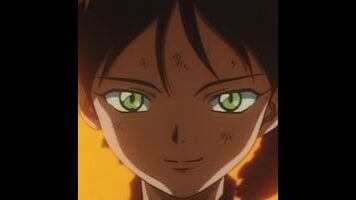“Speak Like A Child” is a time capsule, an episode that immediately dates itself by alluding to Beta and VHS tapes as antiques. Keep in mind: Cowboy Bebop’s original run was in 1999, so this was only a couple of years after DVD was first introduced into the market in 1995. By this point, DVD technology had started to catch on. The first half of the episode, wherein Jet and Spike try to find out about a mysterious Beta cassette tape that arrives COD for Faye, is an acknowledgment of the miniature revolutions that we use to mark the passage of time. One minute it’s Beta and VHS tapes, the next it’s DVD and then data discs. My, how time flies.
For the longest time, “Speak Like A Child” doesn’t seem to have much on its mind. During the episode’s first half, we get a bunch of one-note jokes at the expense of a nerd that values retro forms of technology. Then it’s a hunt for unknown treasure. Then, finally, the whatsit that Spike and Jet have been trying to watch throughout the episode is revealed to also be a time capsule, one Faye made a decade ago and sent to her future self.
The episode begins with Jet telling Ed a story about a fisherman that is gifted a magical “Tamatebako” by magical Ryuuguujou, which Jet explains is a kind of magical fish. After Ed assumes that a Tamatebako is a kind of food, Jet explains to her that it is in fact a kind of treasure. Beyond that, who knows what a Tamatebako is? As it’s defined in the episode, it’s basically something precious and, according to Spike later on in the episode, hard to acquire.
After that, a mysterious package literally drops out of the sky addressed to Faye. She flees in a panic. Faye doesn’t know who the package is from and she’s afraid it’s more bad news from her past. Maybe it’s from the collection agency that’s trying to get her to pay back the money she owes for her medical procedures. Maybe it’s something worse that she can’t think of. Either way, Faye runs away and heads to a racetrack to try to calm herself down.
Meanwhile, Spike and Jet go open the package and discover it’s a Beta cassette tape, one that cannot be played without special equipment. Their perplexed reaction to the tape is pretty priceless, even if it is a one-note joke. “What the hell is it,” Jet asks Spike nervously after he first opens the package. The tape makes a rattling noise as he inspects it, bringing back memories of the clunky tactility of VHS tapes. “Does it makes a ticking noise,” Jet continues as his mind races.
For my money, “Speak Like A Child” only starts to get really good once Spike and Jet go in search of Faye’s Tamatebako. The scene where they, without explanation, start to navigate a subterranean shopping mall in search of a Beta player is especially memorable. Here, the show’s animators really get to flex their muscles as this scene is entirely reliant on Spike and Jet’s exploration of the now decrepit mall. Watching our heroes climb down an elevator shaft is as satisfying as it is because this scene is entirely reliant on atmosphere. The elevator climb scene is all about luxuriating in the texture of the walls, the creaking of the rusty metal supporting the elevator they’re descending towards and the deep abiding silence in the elevator before the cable snaps for a second time.
Because we don’t know exactly what they’re looking for (the montage ends with Jet moaning, “Why are we going through all of this?”), this montage sequence is very much about how much fun it is to explore new surroundings, like when Spike and Jet slide down a gnarled purple stairway banister located next to a subterranean waterfall. I love this sequence because the show’s animators really get to show off what they can do just by developing a single location as prominently as they do here. Many human characters in Cowboy Bebop are not as well as well-conceived as this building is.
After all that foraging, it’s extremely touching to see what’s on Faye’s tape: images of a young Faye happily cheering on her future self. Young Faye photographs herself at the beach, in her home, highlighting all the stuff that defines young Faye: the stuffed animals on the wall, the framed pictures, the neat desk with a potted plant and textbook. This is the Faye of then trying to imagine what to say, what to project to the Faye of the future (ie: the Faye of Cowboy Bebop’s present). “Today, you are who you are today,” the Faye on the tape says. “You are a newer version of me. Myself ten years from now. That’s so far away for me that I can’t even begin to imagine.”
“Is this…me,” contemporary Faye wonders aloud, struggling to process the meaning of this tape. As if in anticipation of this question, the Faye on the tape says, “I’m no longer here. But I’m here today, and I’ll always be cheering for you right here. Cheering for you, my only self.” This is crucial for Faye because, after “My Funny Valentine,” she pretty much had to accept not having a past. Now she has a singular memory to hold onto, one that she knows empirically is true because, well, there it is recorded on a Beta cassette. It doesn’t matter where Faye is now because at this moment in time, she, one member in a band of nomadic bounty hunters, has a document to prove that she had previously existed. It’s a touching sentiment and a good part of what makes this week’s Cowboy Bebop really exceptional.









![HBO teases new Euphoria, Larry David, and much more in 2026 sizzle reel [Updated]](https://img.pastemagazine.com/wp-content/avuploads/2025/12/12100344/MixCollage-12-Dec-2025-09-56-AM-9137.jpg)































